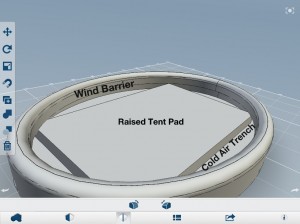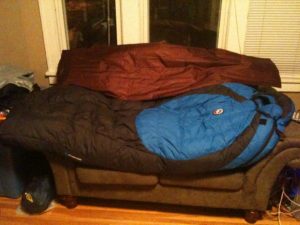 Last year I wrote a “How-to” set your tent in the snow to maximize warmthyness whilst winter camping. To be honest, that is where your cold-weather sleep system begins. If it’s too humid, too drafty, unprotected (assuming there’s wind protection available), or in any other way susceptible to the harsh winter weather, you’re gonna have a bad time. But since you read my post and admired my exquisite 3D CAD drawings, you know exactly how to protect against all of those things.
Last year I wrote a “How-to” set your tent in the snow to maximize warmthyness whilst winter camping. To be honest, that is where your cold-weather sleep system begins. If it’s too humid, too drafty, unprotected (assuming there’s wind protection available), or in any other way susceptible to the harsh winter weather, you’re gonna have a bad time. But since you read my post and admired my exquisite 3D CAD drawings, you know exactly how to protect against all of those things.
So today, I start a series on your entire sleeping system. First up: Sleeping pads
Winter Camping Sleeping Pads
Which pad(s) you choose to bring with you very much depends on the other activities surrounding your winter camping experience. If you’re doing some legit winter mountaineering, you’re probably sleeping in a snow cave and trying to cut pack weight and pack size. Or even if you do bring a tent, size and weight is still an issue.But let’s say you’re a beginner. You’re doing a more casual winter camp and can carry more gear. Perhaps you’re car camping and pulling right up to the tent pad, or maybe you’re just going to snowshoe in a mile or so. OORRRRRRRRRR, you’re not a beginner and you’re doing something totally rad like ski-touring and pulling a pulk sled.
All of these things matter when choosing your sleeping pad(s).
R-Value
This is the rating used to determine how much you’ll be insulated from the ground. For winter camping, the higher the R-value, the better. You’ll learn more about this later on, ya heard?
Closed-Cell Foam Pad
If you fall into the first category of activities I mentioned, I’m probably wondering why you’re reading this as you’re already sufficiently badass. But just in case you’re not, all you reeeaaalllllly need is a closed-cell foam pad. The thick layer of snow beneath you will insulate you from the frozen earth, and the closed-cell foam will insulate you from the snow. In this case, a very very warm sleeping bag is very required.
The R-value of a closed cell foam pad is right around 2, give or take a few digits after a decimal point. i.e. 2.x. This is why a heavily insulated sleeping bag is required if you’re just using a foam pad, but fret not, there are hundreds of millions (if not billions) of mountaineers that get by with just this every single day. Emphasis on the billion mountaineers.
Inflatable Insulated Sleeping Pads
If you fall into the second category of activities, you can tolerate the extra weight. In this case, I say bring two (2!!!) sleeping pads for true winter camping luxury. Not only can you more than double your R-value, but sleeping on a cushion of air is much more comfortable than a thin little piece of foam.
You can find insulated inflatable pads at R-4 or higher depending on your needs and budget. Typically, the higher the R-value the more the pad will weigh and more space it will take up. Again, not a big deal if you’re hauling it on a pulk sled or driving up to your site, but if you determine what you can really get away with, you might be able to sneak an inflatable with you on your mountaineering trek. When I am afforded the option of bringing two pads, I never leave the house without a combined R-value of 6 or higher.
Sleeping Pad Bonus Tip
I am not the first person to ever write about sleeping pads for winter camping, but I will say I haven’t ever read anyone suggesting this. This was born out of my own sleeping system and discovered the hard way. Read: freezing my butt off at night.
Most other posts you’ll read will tell you to put your closed-cell foam pad down first, then the inflatable one, then your sleeping bag. I’m saying this isn’t ideal.
R-values are additive regardless of how you use them so in that regard, it doesn’t matter what order you put them down. But let’s logically look at each pad.
A closed-cell pad is solid foam, through and through. An inflatable pad is only insulated directly on the external material, and the rest is filled with air. Air that can become chilled and cold and eventually end up as the same temperature as the outside temperature. It’s winter, remember? That outside air temperature can easily be in the teens or single digits. Do you really want that cold air right against your sleeping bag/body? I didn’t think so.
Just like the foam pad would insulate you from the cold snow, it can also insulate you from the cold air that filled your inflatable pad. So I always put my inflatable pad down first, then the closed-cell pad on top, and then my sleeping bag.
The combined R-value is still 6 or above, and I still get the added comfort of floating on a pillow of air while I sleep. If this ain’t genius, I don’t know what is.
Next in the winter camping sleeping series: Sleeping bags
Stay tuned!









Duuuuuuuddddeeeee, you gotta, JUST GOTTA, plug the exped here. In my sometimes not so humble opinion, you just can’t beat an inflatable pad with down insulation.